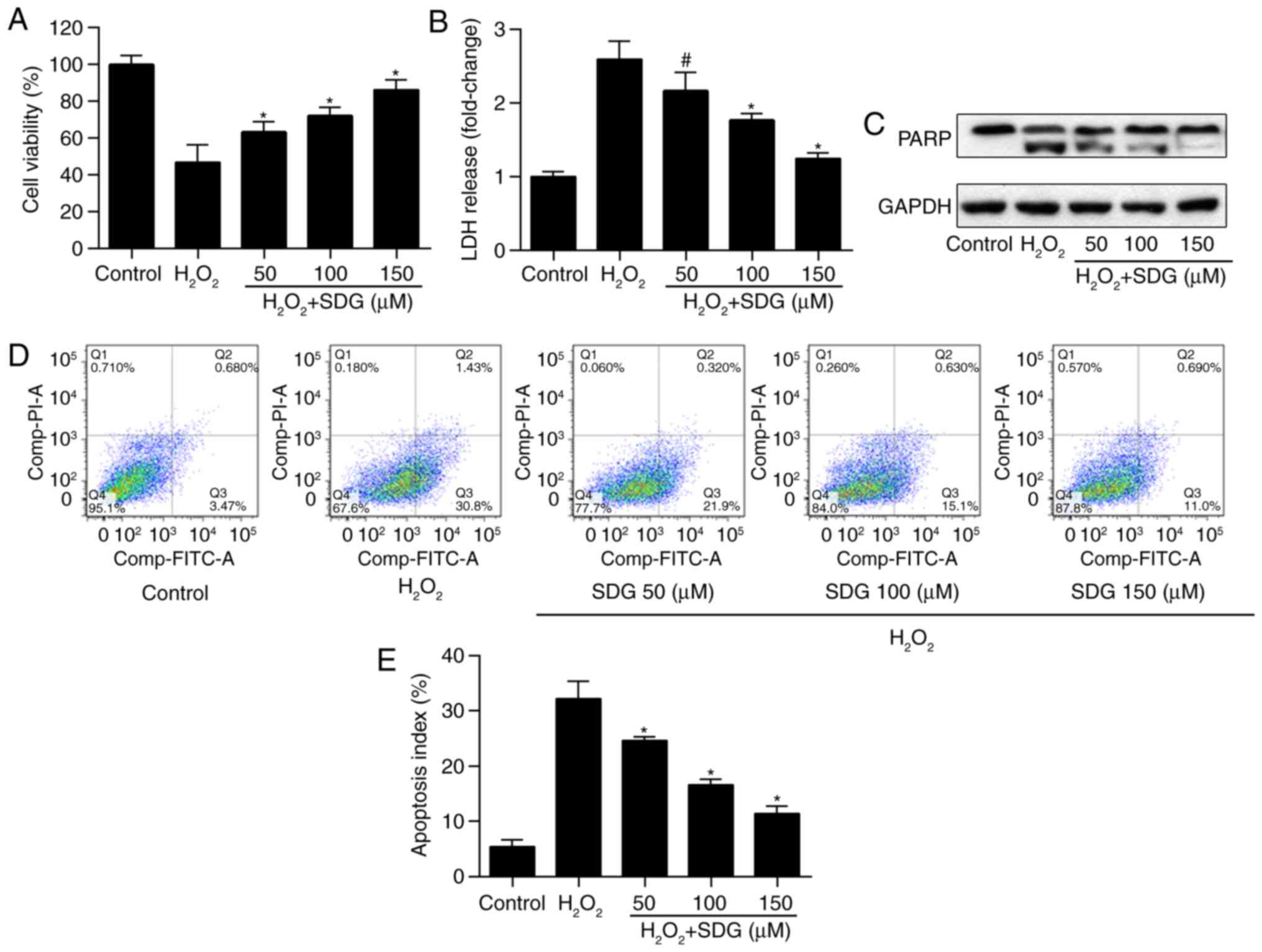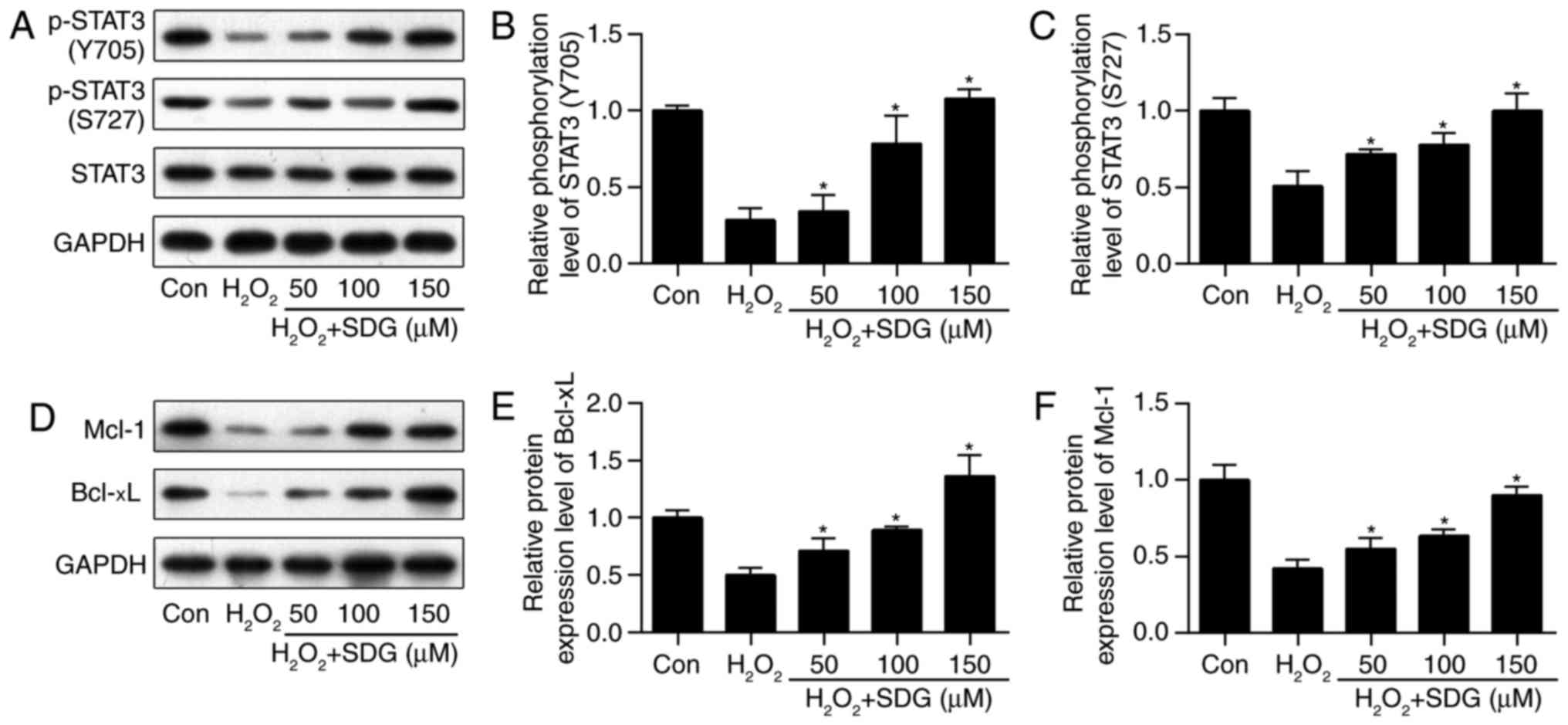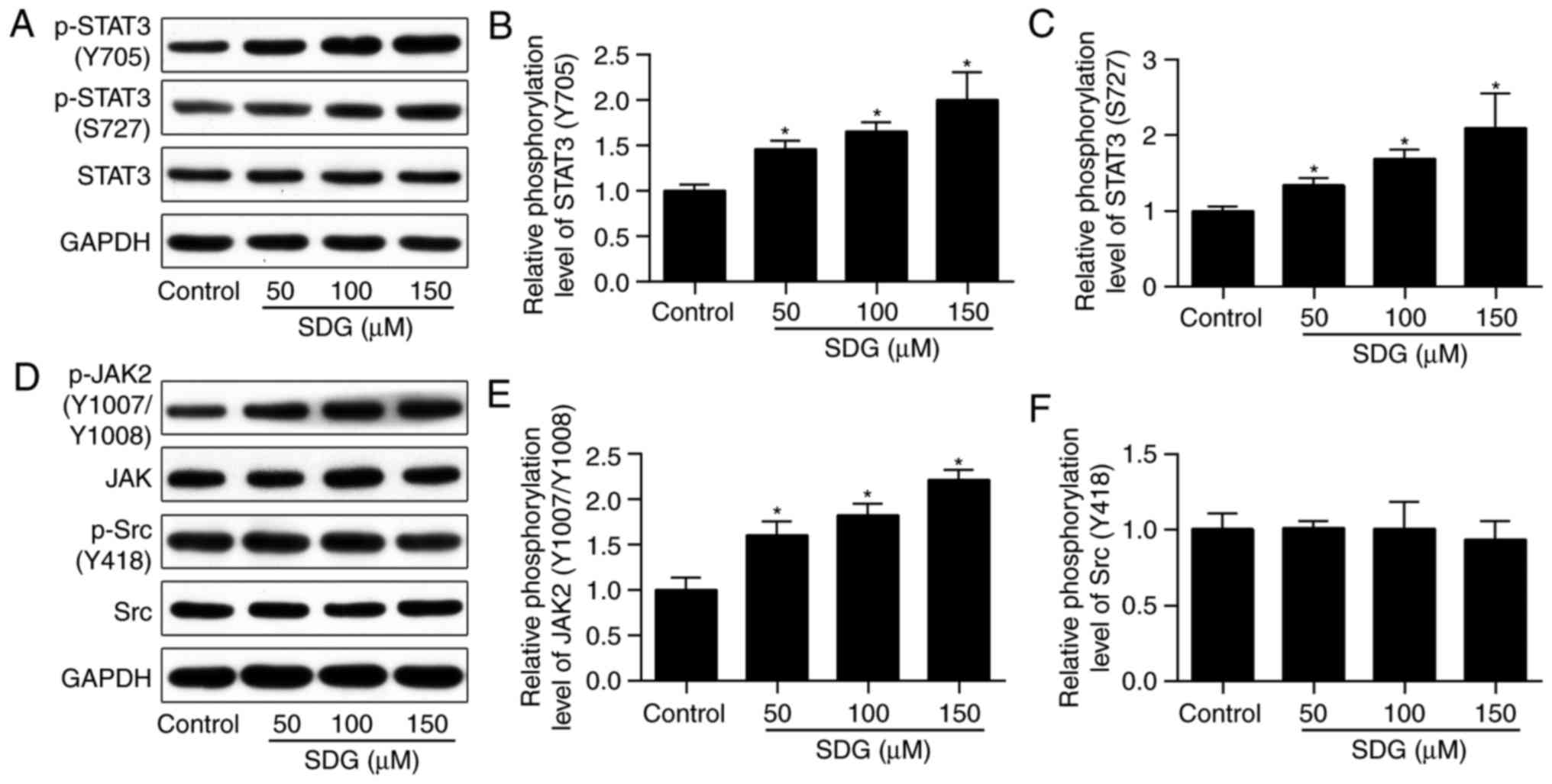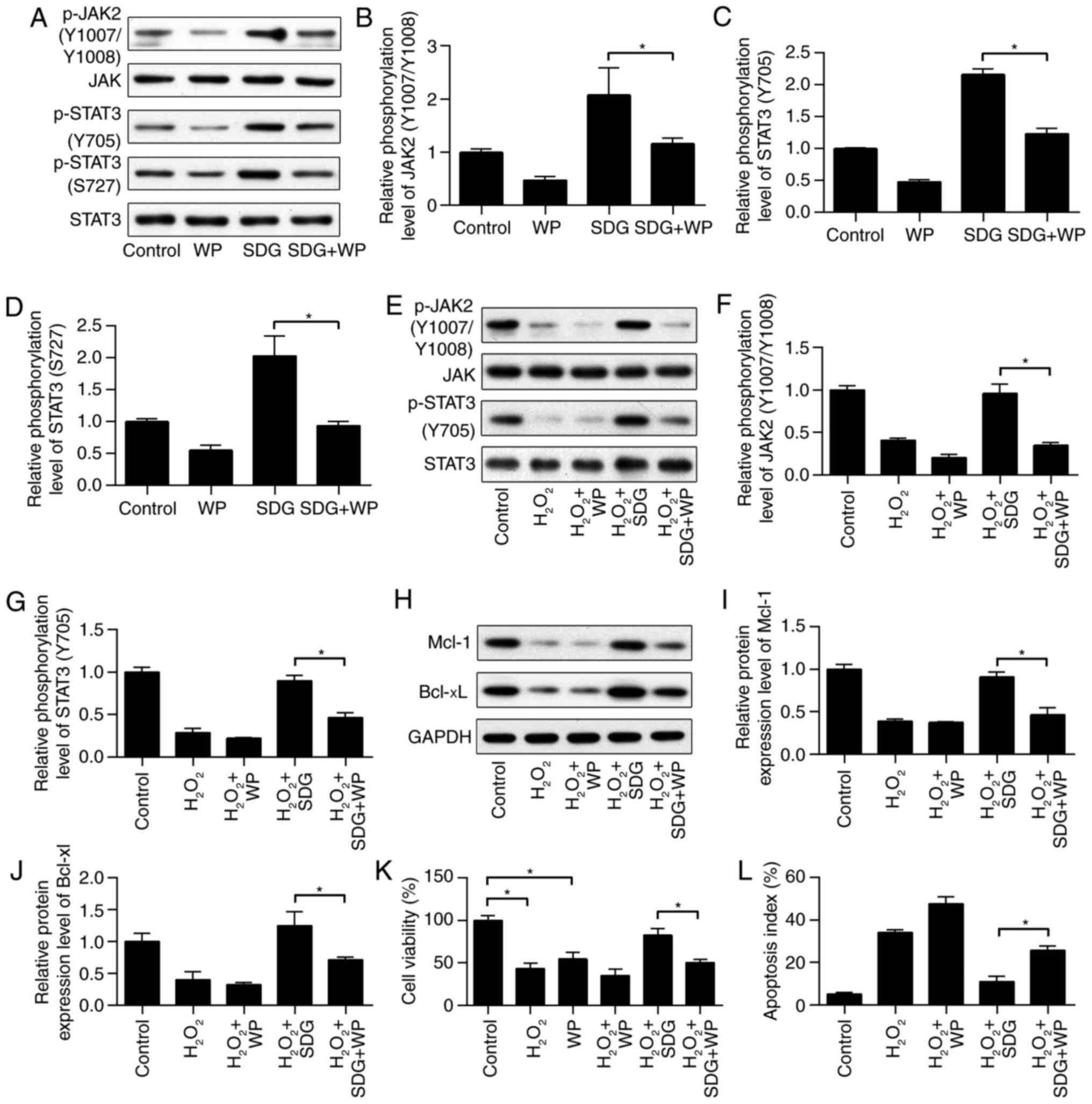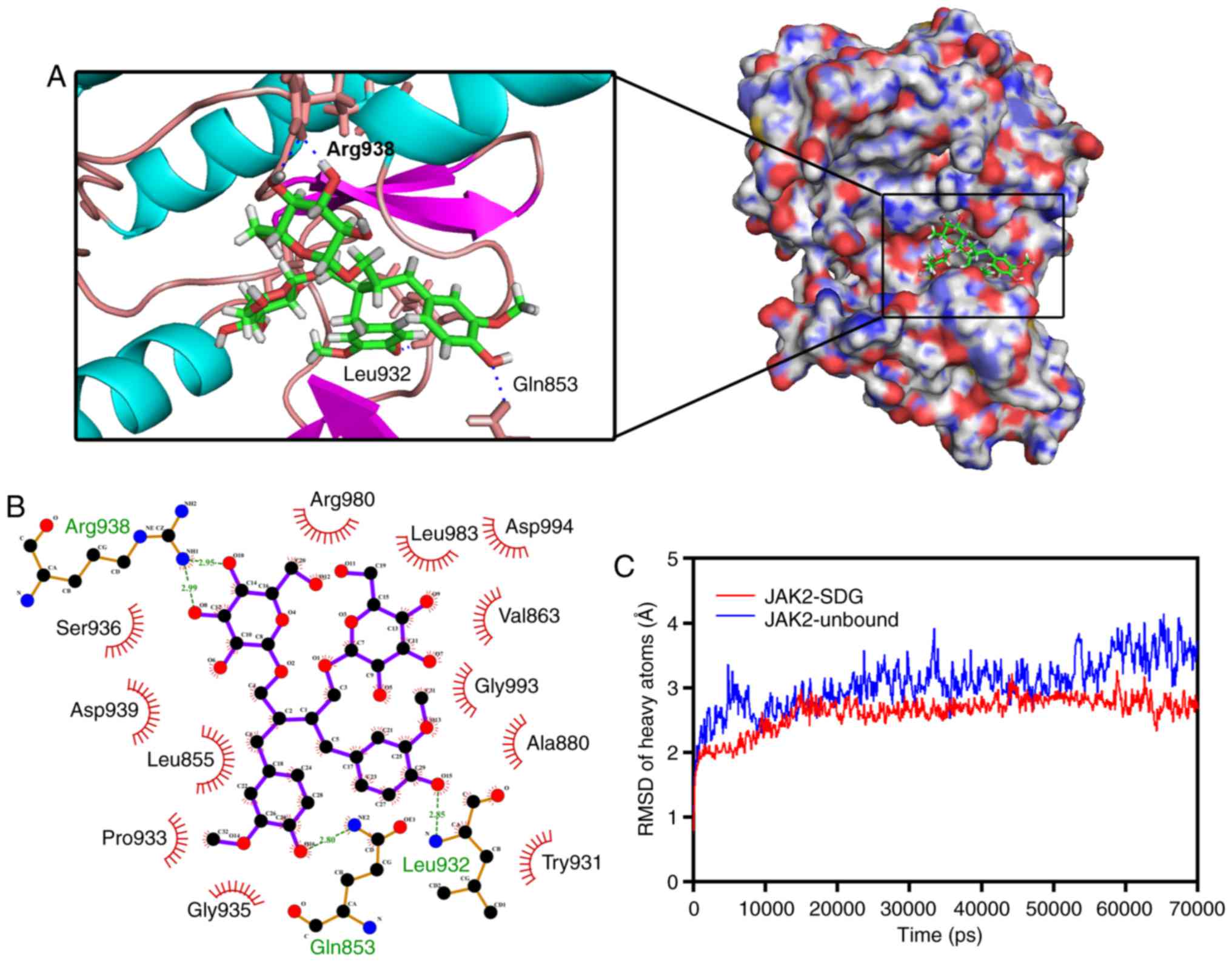|
1
|
Benjamin EJ, Blaha MJ, Chiuve SE, Cushman
M, Das SR, Deo R, de Ferranti SD, Floyd J, Fornage M, Gillespie C,
et al: Heart disease and stroke statistics-2017 update: A report
from the American heart association. Circulation. 135:e146–e603.
2017. View Article : Google Scholar : PubMed/NCBI
|
|
2
|
Singh SS and Kang PM: Mechanisms and
inhibitors of apoptosis in cardiovascular diseases. Curr Pharm Des.
17:1783–1793. 2011. View Article : Google Scholar : PubMed/NCBI
|
|
3
|
Zhao ZQ: Oxidative stress-elicited
myocardial apoptosis during reperfusion. Curr Opin Pharmacol.
4:159–165. 2004. View Article : Google Scholar : PubMed/NCBI
|
|
4
|
Hamacher-Brady A, Brady NR and Gottlieb
RA: The interplay between pro-death and pro-survival signaling
pathways in myocardial ischemia/reperfusion injury: Apoptosis meets
autophagy. Cardiovasc Drugs Ther. 20:445–462. 2006. View Article : Google Scholar : PubMed/NCBI
|
|
5
|
Slavova-Kazakova A, Karamać M, Kancheva V
and Amarowicz R: Antioxidant activity of flaxseed extracts in lipid
systems. Molecules. 21:E172015. View Article : Google Scholar : PubMed/NCBI
|
|
6
|
Prasad K and Dhar A: Flaxseed and
diabetes. Curr Pharm Des. 22:141–144. 2016. View Article : Google Scholar
|
|
7
|
Prasad K: Flaxseed and cardiovascular
health. J Cardiovasc Pharmacol. 54:369–377. 2009. View Article : Google Scholar : PubMed/NCBI
|
|
8
|
Penumathsa SV, Koneru S, Thirunavukkarasu
M, Zhan L, Prasad K and Maulik N: Secoisolariciresinol diglucoside:
Relevance to angiogenesis and cardioprotection against
ischemia-reperfusion injury. J Pharmacol Exp Ther. 320:951–959.
2007. View Article : Google Scholar
|
|
9
|
Penumathsa SV, Koneru S, Zhan L, John S,
Menon VP, Prasad K and Maulik N: Secoisolariciresinol diglucoside
induces neovascularization-mediated cardioprotection against
ischemia-reperfusion injury in hypercholesterolemic myocardium. J
Mol Cell Cardiol. 44:170–179. 2008. View Article : Google Scholar
|
|
10
|
Puukila S, Bryan S, Laakso A, Abdel-Malak
J, Gurney C, Agostino A, Belló-Klein A, Prasad K and Khaper N:
Secoisolariciresinol diglucoside abrogates oxidative stress-induced
damage in cardiac iron overload condition. PLoS One.
10:e1228522015. View Article : Google Scholar
|
|
11
|
Boengler K, Hilfiker-Kleiner D, Drexler H,
Heusch G and Schulz R: The myocardial JAK/STAT pathway: From
protection to failure. Pharmacol Ther. 120:172–185. 2008.
View Article : Google Scholar : PubMed/NCBI
|
|
12
|
Bolli R, Stein AB, Guo Y, Wang OL, Rokosh
G, Dawn B, Molkentin JD, Sanganalmath SK, Zhu Y and Xuan YT: A
murine model of inducible, cardiac-specific deletion of STAT3: Its
use to determine the role of STAT3 in the upregulation of
cardioprotective proteins by ischemic preconditioning. J Mol Cell
Cardiol. 50:589–597. 2011. View Article : Google Scholar : PubMed/NCBI
|
|
13
|
Xuan YT, Guo Y, Han H, Zhu Y and Bolli R:
An essential role of the JAK-STAT pathway in ischemic
preconditioning. Proc Natl Acad Sci USA. 98:9050–9055. 2001.
View Article : Google Scholar : PubMed/NCBI
|
|
14
|
Suleman N, Somers S, Smith R, Opie LH and
Lecour SC: Dual activation of STAT-3 and Akt is required during the
trigger phase of ischaemic preconditioning. Cardiovasc Res.
79:127–133. 2008. View Article : Google Scholar : PubMed/NCBI
|
|
15
|
Hilfiker-Kleiner D, Hilfiker A, Fuchs M,
Kaminski K, Schaefer A, Schieffer B, Hillmer A, Schmiedl A, Ding Z,
Podewski E, et al: Signal transducer and activator of transcription
3 is required for myocardial capillary growth, control of
interstitial matrix deposition, and heart protection from ischemic
injury. Circ Res. 95:187–195. 2004. View Article : Google Scholar : PubMed/NCBI
|
|
16
|
Jacoby JJ, Kalinowski A, Liu MG, Zhang SS,
Gao Q, Chai GX, Ji L, Iwamoto Y, Li E, Schneider M, et al:
Cardiomyocyte-restricted knockout of STAT3 results in higher
sensitivity to inflammation, cardiac fibrosis, and heart failure
with advanced age. Proc Natl Acad Sci USA. 100:12929–12934. 2003.
View Article : Google Scholar : PubMed/NCBI
|
|
17
|
Liu B, Zhang J, Liu W, Liu N, Fu X, Kwan H
and Liu S, Liu B, Zhang S, Yu Z and Liu S: Calycosin inhibits
oxidative stress-induced cardiomyocyte apoptosis via activating
estrogen receptor-α/β. Bioorg Med Chem Lett. 26:181–185. 2016.
View Article : Google Scholar
|
|
18
|
Liu B, Liu NN, Liu WH, Zhang SW, Zhang JZ,
Li AQ and Liu SM: Inhibition of lectin-like oxidized low-density
lipoprotein receptor-1 reduces cardiac fibroblast proliferation by
suppressing GATA binding protein 4. Biochem Biophys Res Commun.
475:329–334. 2016. View Article : Google Scholar : PubMed/NCBI
|
|
19
|
Su Q, Ioannidis S, Chuaqui C, Almeida L,
Alimzhanov M, Bebernitz G, Bell K, Block M, Howard T, Huang S, et
al: Discovery of 1-methyl-1H-imidazole derivatives as potent Jak2
inhibitors. J Med Chem. 57:144–158. 2014. View Article : Google Scholar
|
|
20
|
Trott O and Olson AJ: AutoDock Vina:
Improving the speed and accuracy of docking with a new scoring
function, efficient optimization, and multithreading. J Comput
Chem. 31:455–461. 2010.
|
|
21
|
Yang Y, Hu B and Lill MA: WATsite2.0 with
PyMOL Plugin: Hydration site prediction and visualization. Methods
Mol Biol. 1611:123–134. 2017. View Article : Google Scholar : PubMed/NCBI
|
|
22
|
Laskowski RA and Swindells MB:
LigPlot+: Multiple ligand-protein interaction diagrams
for drug discovery. J Chem Inf Model. 51:2778–2786. 2011.
View Article : Google Scholar : PubMed/NCBI
|
|
23
|
Krieger E, Koraimann G and Vriend G:
Increasing the precision of comparative models with YASARA NOVA-a
self-parameterizing force field. Proteins. 47:393–402. 2002.
View Article : Google Scholar : PubMed/NCBI
|
|
24
|
Teng Y, Ross JL and Cowell JK: The
involvement of JAK-STAT3 in cell motility, invasion, and
metastasis. JAKSTAT. 3:e280862014.PubMed/NCBI
|
|
25
|
Nam S, Xie J, Perkins A, Ma Y, Yang F, Wu
J, Wang Y, Xu RZ, Huang W, Horne DA and Jove R: Novel synthetic
derivatives of the natural product berbamine inhibit Jak2/Stat3
signaling and induce apoptosis of human melanoma cells. Mol Oncol.
6:484–493. 2012. View Article : Google Scholar : PubMed/NCBI
|
|
26
|
Niu G, Bowman T, Huang M, Shivers S,
Reintgen D, Daud A, Chang A, Kraker A, Jove R and Yu H: Roles of
activated Src and Stat3 signaling in melanoma tumor cell growth.
Oncogene. 21:7001–7010. 2002. View Article : Google Scholar : PubMed/NCBI
|
|
27
|
Song B, Jin H, Yu X, Zhang Z, Yu H, Ye J,
Xu Y, Zhou T, Oudit GY, Ye JY, et al: Angiotensin-converting enzyme
2 attenuates oxidative stress and VSMC proliferation via the
JAK2/STAT3/SOCS3 and profilin-1/MAPK signaling pathways. Regul
Pept. 185:44–51. 2013. View Article : Google Scholar : PubMed/NCBI
|
|
28
|
Podewski EK, Hilfiker-Kleiner D, Hilfiker
A, Morawietz H, Lichtenberg A, Wollert KC and Drexler H:
Alterations in Janus kinase (JAK)-signal transducers and activators
of transcription (STAT) signaling in patients with end-stage
dilated cardiomyopathy. Circulation. 107:798–802. 2003. View Article : Google Scholar : PubMed/NCBI
|
|
29
|
Zhang W, Qu X, Chen B, Snyder M, Wang M,
Li B, Tang Y, Chen H, Zhu W, Zhan L, et al: Critical roles of STAT3
in β-adrenergic functions in the heart. Circulation. 133:48–61.
2016. View Article : Google Scholar
|
|
30
|
Reed DK and Arany I: Sex hormones
differentially modulate STAT3-dependent antioxidant responses
during oxidative stress in renal proximal tubule cells. In Vivo.
28:1097–1100. 2014.PubMed/NCBI
|
|
31
|
Carpenter RL and Lo HW: STAT3 target genes
relevant to human cancers. Cancers (Basel). 6:897–925. 2014.
View Article : Google Scholar
|
|
32
|
Chen-Scarabelli C, Saravolatz IL, McCaukey
R, Scarabelli G, Di Rezze J, Mohanty B, Barry S, Latchman D,
Georgiadis V, McCormick J, et al: The cardioprotective effects of
urocortin are mediated via activation of the Src tyrosine
kinase-STAT3 pathway. JAKSTAT. 2:e248122013.
|
|
33
|
Czemplik M, Kulma A, Bazela K and Szopa J:
The biomedical potential of genetically modified flax seeds
overexpressing the glucosyltransferase gene. BMC Complement Altern
Med. 12:2512012. View Article : Google Scholar : PubMed/NCBI
|



